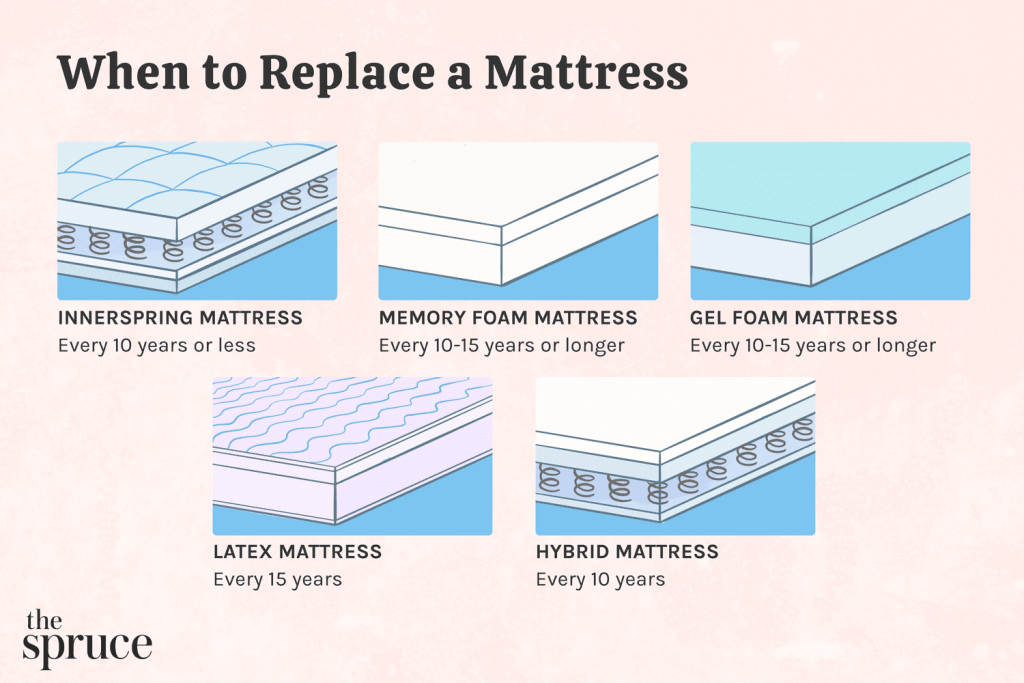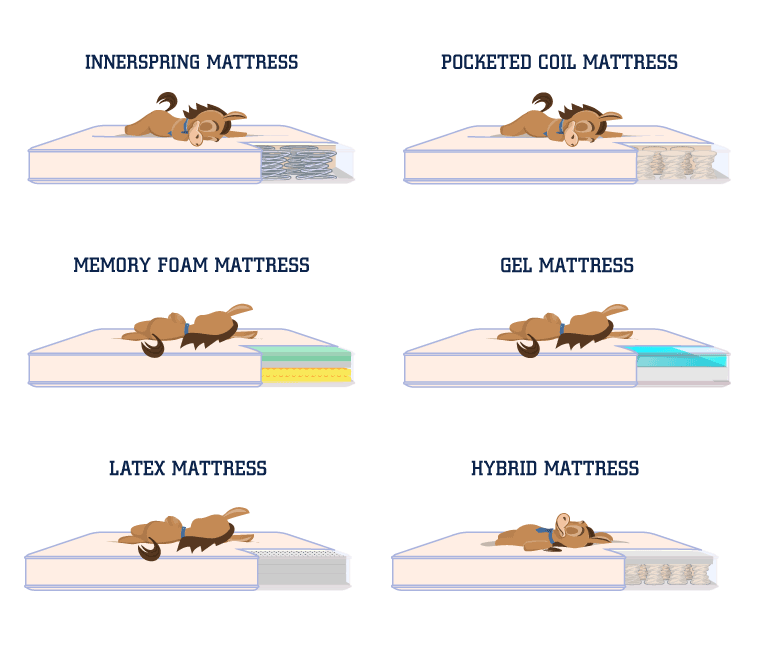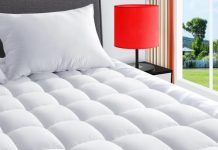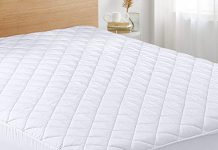Are you wondering how often you should replace your mattress?
The answer might surprise you. While mattresses are built to last, they are not meant to last forever.
Experts suggest that you should replace your mattress every 8 to 10 years. However, this timeline can vary depending on factors such as the quality of your mattress, your sleep habits, and any noticeable signs of wear and tear.
So, if you’ve been waking up feeling less refreshed or noticing sagging areas, it might be time to consider investing in a new mattress for a better night’s sleep.
Review contents
Factors Affecting Mattress Lifespan
Quality of the mattress materials
The quality of the materials used in a mattress plays a significant role in determining its lifespan.
A high-quality mattress made from durable materials such as high-density foam or pocketed coils will likely last longer than a low-quality mattress. When purchasing a mattress, it’s essential to consider the materials’ quality to ensure that it can withstand regular use without deteriorating quickly.
Frequency and weight of use
The frequency and weight of use are also essential factors that can affect the lifespan of a mattress. If you use your mattress every night for an extended period, it will likely wear out faster than one used less frequently.
Additionally, if you or your partner are heavier, the mattress may experience more strain and wear out quicker. It’s essential to consider these factors when determining how long your mattress will likely last.
Degree of maintenance and care
The maintenance and care you provide to your mattress can significantly impact its lifespan. Regularly cleaning your mattress, using a mattress cover or protector, and rotating or flipping it can help to minimize wear and tear.
Additionally, following the manufacturer’s guidelines for care and maintenance, such as avoiding excessive jumping on the bed or exposing it to direct sunlight, can help prolong its lifespan.
Environmental conditions
The environmental conditions in which your mattress is used can also affect its lifespan. Excessive moisture or humidity can lead to the growth of mold and mildew, which can damage the mattress and reduce its lifespan.
Similarly, extreme temperatures or exposure to direct sunlight can cause the materials in the mattress to deteriorate more quickly. Ensuring your mattress is used in a suitable environment to maximize its lifespan is essential.
Changes in personal needs and preferences
Lastly, changes in your personal needs and preferences can also influence the lifespan of your mattress. For example, if you experience a weight change or develop specific health concerns, you may need to replace your mattress to accommodate these changes.
Additionally, if your preferences for mattress firmness or support level change over time, you may find that your current mattress no longer meets your needs, prompting the need for a replacement.
Signs that it’s time to replace your mattress
Visible wear and tear
One of the most noticeable signs that it’s time to replace your mattress is visible wear and tear. This can include signs such as sagging or indentations in the mattress surface, frayed or torn fabric, or exposed springs.
Suppose you notice any significant damage or deterioration in your mattress. In that case, it indicates that it is no longer providing the support and comfort it once did, and it’s time to start considering a replacement.
Sagging or unevenness
Another sign that your mattress may need to be replaced is the presence of sagging or unevenness. Over time, mattresses can develop sagging areas where the materials have compressed under the weight of your body.
This can lead to discomfort and a lack of proper support, negatively affecting your sleep quality. If your mattress has noticeable sagging or unevenness, it may be time to invest in a new one.
Lack of support and comfort
As mattresses age, they can lose their ability to provide adequate support and comfort. You may start noticing that you wake up with aches and pains or have trouble finding a comfortable position.
If your mattress no longer provides the support and comfort you need for a restful night’s sleep, it’s a strong indication that it’s time to replace it.
Allergies or health concerns
If you develop allergies or have specific health concerns, it may be necessary to replace your mattress. Mattresses can accumulate dust mites, allergens, and other irritants, exacerbating allergy symptoms or respiratory issues.
Suppose your allergies are intensified, or your health symptoms worsen when you sleep on your mattress. In that case, it’s advisable to consider replacing it with a hypoallergenic or more suitable option.
Disturbed sleep or waking up tired
One of the most obvious signs that it’s time to replace your mattress is experiencing disturbed sleep or consistently waking up tired. Your mattress should provide a comfortable and supportive sleep surface that allows you to rest and rejuvenate.
Find yourself tossing and turning throughout the night or constantly waking up feeling groggy or unrested. It may indicate that your mattress is no longer doing its job effectively and needs to be replaced.
Recommended lifespan for different mattress types
Innerspring mattresses
Innerspring mattresses typically have a lifespan of 7-10 years. This type of mattress comprises a network of metal springs that provide support and bounce.
Over time, the springs can lose their elasticity and become less supportive, leading to sagging and discomfort. However, an innerspring mattress can last on the higher end of the lifespan range with proper care and maintenance.
Memory foam mattresses
Memory foam mattresses have a recommended lifespan of 7-10 years. These mattresses are known for their ability to contour to your body, providing excellent pressure relief and support. However, the foam can break down over time, leading to sagging or a loss of support. Rotating and flipping the mattress regularly to minimize wear and extend its lifespan is essential.
Latex mattresses
Latex mattresses are highly durable and last 10-12 years or even longer. Latex is a natural material that has excellent elasticity and resilience, allowing it to maintain its shape and supportiveness over time. Latex mattresses are often considered a long-lasting investment due to their durability and ability to withstand regular use without significant wear and tear.
Hybrid mattresses
Hybrid mattresses, which combine the benefits of innerspring and foam mattresses, typically have a lifespan of 8-10 years.
The combination of springs and foam layers provides a balance of support and comfort. However, the foam components may still deteriorate over time, so proper care and maintenance are essential to ensure the longevity of a hybrid mattress.
Airbeds
Airbeds, which allow for adjustable firmness levels by inflating or deflating air chambers, can last 8-10 years or longer. The longevity of an airbed often depends on the quality of the materials used and how well the mattress is maintained.
Regularly checking for leaks, keeping the pump in good condition, and following the manufacturer’s guidelines for care can help prolong the lifespan of an airbed.
Factors to consider when replacing a mattress
Budget
When replacing a mattress, budget is an essential factor to consider. Mattresses can vary significantly in price, ranging from budget-friendly options to high-end luxury models.
It’s essential to set a reasonable budget for your financial situation and look for mattresses within that price range. Remember that a good mattress is an investment in your sleep quality and overall well-being, so allocating a reasonable budget is worth allocating to ensure you get a quality product.
Sleeping position and body type
Your sleeping position and body type should also influence your decision when replacing a mattress. Different types of mattresses offer varying levels of support and comfort for different sleep positions and body types.
For example, side sleepers may benefit from a softer mattress cushioning their pressure points, while back or stomach sleepers may prefer a firmer mattress that keeps their spine aligned.
Mattress size and compatibility with bed frame
Consider the size of the mattress you need when replacing your current one. If you’re replacing a mattress and keeping the same bed frame, ensure the new mattress is compatible with the frame’s dimensions.
Mattress sizes can vary, so double-check the measurements to avoid compatibility issues. Additionally, if you’re considering upgrading to a larger or smaller mattress, consider the available space in your bedroom.
Preferred level of firmness or softness
Everyone has different preferences regarding the firmness or softness of a mattress. Some prefer a firm mattress with ample support, while others enjoy a plush and soft sleep surface. When replacing your mattress, consider your preferred level of firmness or softness to ensure that the new mattress meets your comfort needs.
Trial period and warranty
Before purchasing a new mattress, one must inquire about the trial period and warranty the manufacturer or retailer offers. A trial period allows you to test out the mattress in your home and return it if you’re unsatisfied.
Additionally, a good warranty assures that the manufacturer stands behind the quality of their product and will address any defects or issues that may arise. Pay attention to the length of the trial period, warranty, and any specific terms and conditions.
Tips for maximizing mattress lifespan
Using a mattress protector
Investing in a high-quality mattress protector can help prolong the lifespan of your mattress. A mattress protector is a barrier between the mattress and potential stains, spills, or accidents.
It can also protect against dust mites and allergens, keeping your mattress clean and hygienic. Be sure to choose a waterproof and breathable mattress protector that fits securely around the mattress.
Rotating and flipping the mattress
To ensure even wear and minimize sagging, rotating and flipping your mattress regularly is recommended. Most mattresses can be rotated from top to bottom and flipped from side to side.
This helps distribute the weight and pressure more evenly across the mattress, preventing certain areas from becoming overly compressed. Check the manufacturer’s instructions for specific guidelines on rotating and flipping your mattress.
Keeping the mattress clean
Regularly cleaning your mattress can help maintain its condition and extend its lifespan. Vacuuming the mattress surface can remove dust, dirt, and allergens, while spot cleaning can address any spills or stains. Airing out the mattress occasionally by removing bedding and allowing it to breathe can also help reduce moisture and prevent mold or mildew growth. Consult the manufacturer’s guidelines for detailed cleaning instructions.
Avoiding jumping or excessive weight on the bed
Jumping on the bed or placing excessive weight on a mattress can cause damage and reduce lifespan. Mattresses are designed to support the sleeper’s weight, and any additional weight should be within its recommended limits.
Excessive force or pressure can lead to sagging, indentations, or even broken springs. Educate children about the importance of treating the mattress carefully and refrain from engaging in activities that may put unnecessary strain on the bed.
Avoiding excessive exposure to sunlight
Direct sunlight can cause the materials in a mattress to deteriorate more quickly. Avoid placing your mattress in direct sunlight or exposing it to excessive heat.
If you have windows in your bedroom, consider using curtains or blinds to block out sunlight during the day. This will help protect your mattress and increase its lifespan.
FAQs about mattress replacement
Can a mattress be too old to use?
Yes, a mattress can become too old to use. Over time, the materials in the mattress break down and lose their ability to provide adequate support and comfort. Depending on the type of mattress and how well it has been maintained, a general guideline is to replace it every 7-10 years, although individual factors may vary.
If you notice significant sagging, lack of support, visible wear and tear, or a decline in sleep quality, it may be time to replace your mattress.
Can you extend the life of a mattress?
Yes, it is possible to extend the life of a mattress with proper care and maintenance. Following the recommended tips, such as using a mattress protector, rotating and flipping the mattress, keeping it clean, avoiding excessive weight or jumping on the bed, and minimizing exposure to sunlight, can help maximize its lifespan.
Regular maintenance and care can help slow down a mattress’s natural wear and tear and ensure that it remains comfortable and supportive for a more extended period.
Is it necessary to replace both the mattress and box spring?
In many cases, replacing the mattress and the box spring together is recommended. A box spring is designed to work with the mattress to provide support and enhance the overall comfort of the sleep surface. If your current box spring is worn out or no longer provides the necessary support, it can impact the performance and lifespan of a new mattress.
When purchasing a new mattress, it’s advisable to check with the manufacturer or retailer to determine if your existing box spring is compatible or if replacing both components is recommended.
What should I do with my old mattress?
When replacing your old mattress, there are several options for its disposal. If the mattress is still in good condition, you may consider donating it to a local charity or shelter. Many organizations accept used mattresses as long as they meet specific guidelines. Alternatively, you can explore options for recycling your mattress. Some cities have mattress recycling programs or facilities to disassemble, recycle, or repurpose materials. If these options are unavailable, you can contact a waste management company to arrange proper disposal.
How can I dispose of an old mattress responsibly?
To responsibly dispose of an old mattress, explore recycling options, donate, or contact a waste management company. Recycling is an environmentally friendly option that allows the materials in the mattress to be repurposed or used in the production of new products.
Donating your mattress to a charity or shelter is a great way to help someone in need while ensuring that the mattress doesn’t end up in a landfill. If there are no recycling or donation options, contact a waste management company to inquire about proper disposal methods in your area.
Conclusion
The lifespan of a mattress is influenced by several factors, including the quality of materials, frequency and weight of use, maintenance and care, environmental conditions, and changes in personal needs and preferences.
By recognizing the signs that it’s time to replace your mattress, such as visible wear and tear, sagging, lack of support, allergies or health concerns, and disturbed sleep, you can decide when to invest in a new mattress.
Different mattress types have varying recommended lifespans, with innerspring mattresses lasting around 7-10 years, memory foam mattresses and hybrid mattresses lasting about the same, latex mattresses lasting 10-12 years or longer, and airbeds lasting 8-10 years or more. Consider factors like budget, sleeping position and body type, mattress size, preferred firmness or softness, and the trial period and warranty when replacing a mattress.
To maximize the lifespan of your mattress, use a mattress protector, rotate and flip the mattress regularly, keep it clean, avoid excessive weight or jumping on the bed, and minimize exposure to sunlight. Remember to replace your mattress when it becomes too old and worn out to provide the necessary support and comfort for a good night’s sleep.
Following these tips and guidelines, you can make an informed decision when replacing your mattress and ensure you enjoy many restful nights on a comfortable and supportive sleep surface.






























